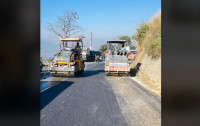National
Cases of missing person go up during Covid-19 pandemic, police records show
The National Human Rights Commission in 2019 had reported that nearly 1.5 million Nepalis are at risk of various forms of human trafficking.
Shuvam Dhungana
On June 28, Bina Sapkota left her home to go meet her friend. The 21-year-old had told her family that she would be home within an hour. She never returned.
For days Sapkota’s family did not file a missing person report. They took it upon themselves to look for her. On July 1, Sapkota’s family finally decided to contact the police.
Chitwan district police then questioned Sapkota’s friend, Pravesh Kandel, the last person to see her.
“Kandel says that Sapkota disappeared while he had gone to withdraw money from an ATM booth and that he had informed her family about her disappearance,” said Deputy Superintendent of Police Surya Thapa, spokesperson for the District Police Office, Chitwan.
Just days before Sapkota’s family filed the missing person report, Chitwan police had received a similar complaint involving 23-year-old Sujita Bhandari.
On July 4, nine days after Bhandari went missing, her body was recovered in a forest, some 3km away from her home.
Bhandari’s death sparked public outrage in Chitwan. Authorities were forced to clamp a curfew after Bhandari’s friends and families took to the street, accusing the police of inaction even when they reported her disappearance.
Meanwhile, Sapkota’s whereabouts remain unknown and police continue to look for her.
Every year, thousands of missing person reports are filed with the Nepal Police. But less than half are found.
According to the data provided by Nepal Police, in the first eight months of the current fiscal year 2020-21 [between mid-July 2020 and mid-March 2021], a total of 10,418 missing person reports were filed across the country. Of them, only 4,412 people have been found so far.
The data also show that over 47 percent of the missing persons were women.
From the fiscal year 2017-18 until the first eight months of the current fiscal year 2020-21, a total of 39,075 missing person reports were filed across the country. Among the missing, 19,095 were women between 18 and 60 years old, according to the data maintained by the police.
Superintendent of Police Anurag Kumar Dwivedi at Anti Human Trafficking Bureau of Nepal Police believes that there is a possibility that many missing women and children are being trafficked to other countries.
Human traffickers have been known to use India as a trafficking destination or a transit country, as the country shares a long porous border with Nepal.
“We have rescued many girls and women from India who were lured by traffickers with false promises of lucrative jobs. Many victims do not inform their family members as they follow the traffickers’ instructions and are later sold to brothels in India,” said Dwivedi.
According to the Anti Human Trafficking Bureau, so far this current fiscal year, Nepal Police and organisations like Maiti Nepal have rescued as many as 86 women who were being trafficked to India.
The National Human Rights Commission in 2019 had reported that nearly 1.5 million Nepalis are at risk of various forms of human trafficking. Most vulnerable among these are aspiring migrant workers, Nepalis working abroad, people in the adult entertainment sector, girls and women from rural areas, missing persons and child labourers.
But Dwivedi says not all missing person reports are related to trafficking cases.
“Some cases are of elopement and some of suicide,” he said.
Senior Superintendent of Police Basanta Bahadur Kunwar, also the spokesperson for Nepal Police, agrees that not all cases of missing person are related to human trafficking.
“While it is true that girls and women are at high trafficking risk, some disappearance incidents turn out to be the case of young women eloping with their boyfriends because their families did not approve of the relationship,” said Kunwar.
He went on to claim that the record of Nepal Police solving fewer disappearance cases is largely to do with the families of the missing persons not informing the police once they reunite with their missing loved ones.
“We start our investigation immediately after receiving a complaint about a missing person,” said Kunwar. “We also circulate the photo of the missing person on social media and to all the police stations to help out with the search work.”
He said police usually intensify their search if they have a reason to suspect that the missing person may have been a victim of human trafficking or other gruesome crimes.




 19.12°C Kathmandu
19.12°C Kathmandu















